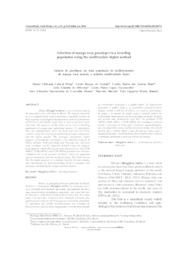Selection of mango rosa genotypes in a breeding population using the multivariate-biplot method.
Selection of mango rosa genotypes in a breeding population using the multivariate-biplot method.
Author(s): MAIA, M. C. C.; ARAÚJO, L. B. de; DIAS, C. T. dos S.; OLIVEIRA, L. C. de; VASCONCELOS, L. F. L.; CARVALHO JÚNIOR, J. E. V. de; SIMEÃO, M.; BASTOS, Y. G. M.
Summary: Mango (Mangifera indica L.) trees stand out among the main fruit trees cultivated in Brazil. The mango rosa fruit is a very popular local variety (landrace), especially because of their superior technological characteristics such as high contents of Vitamin C and soluble solids (SS), as well as attractive taste and color. The objective of this study was to select a breeding population of mango rosa (polyclonal variety; ≥5 individuals) that can simultaneously meet the fresh and processed fruit Vmarkets, using the multivariate method of principal components and the biplot graphic.
Publication year: 2016
Types of publication: Journal article
Unit: Embrapa Mid-North
Keywords: Análise estatística, Análisis estadístico, Biometria, Correlación genotipo-fenotipo, Fitomejoramiento, Manga, Manga rosa, Mangifera Indica, Mangos, Melhoramento genético, Melhoramento genético vegetal, Multivariate-biplot method, Método estatístico, Método multivariado biplot, Seleção genótipa
Observation
Some of Embrapa's publications are published as ePub files. To read them, use or download one of the following free software options to your computer or mobile device. Android: Google Play Books; IOS: iBooks; Windows and Linux: Calibre.
Access other publications
Access the Agricultural Research Database (BDPA) to consult Embrapa's full library collection and records.
Visit Embrapa Bookstore to purchase books and other publications sold by Embrapa.

